Fake Apple Security Warning on iPhone
In recent years, there has been a noticeable surge in phishing scams specifically targeting iPhone users. This uptick is concerning, as these deceptive tactics often mask as legitimate Apple security alerts on iPhone, leading unsuspecting users to inadvertently compromise their own security. Recognizing these fake security warnings is crucial for protecting personal information and maintaining the integrity of one’s digital life.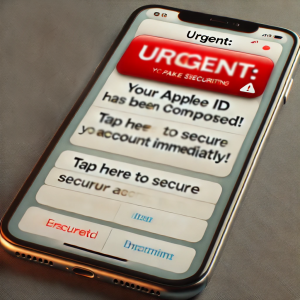
The essence of these scams is to mimic Apple iPhone security alerts, tricking users into believing that their device has been compromised. Whether it’s a virus message on iPhone, the goal of these fraudsters is to instill panic and haste, prompting users to act irrationally. This often involves entering sensitive personal information or downloading malware that further endangers their personal data and the security of their device.
Given the sophisticated nature of these attacks, it’s imperative for iPhone users to be well-informed and vigilant. This blog aims to educate its readers not just on how to identify such scams, but also on the best practices for responding to them without falling victim. By understanding what a genuine Apple iPhone virus warning should look like, and recognizing the signs of a scam, you can secure yourself from these increasingly common cyber threats.
By the end of this blog, you’ll be better equipped to discern between legitimate alerts and those designed to deceive, such as the iPhone virus alert scam pop up, ensuring your digital safety and peace of mind.
Understanding Security Warnings on iPhone
Navigating the landscape of Apple security warnings on your iPhone requires a keen eye for authenticity to distinguish real alerts from fake virus messages. Apple takes meticulous care in how they communicate security alerts on iPhone, making it essential for users to recognize the nuances of these legitimate notifications.
Characteristics of Legitimate Apple Security Alerts
Legitimate Apple security alerts on iPhone are always presented in a professional manner, focusing on security without causing undue alarm. These alerts will never ask for sensitive personal information like passwords or social security numbers directly. Instead, a genuine Apple iPhone security alert might suggest you check settings or verify information through secure channels, emphasizing user safety without immediate demands.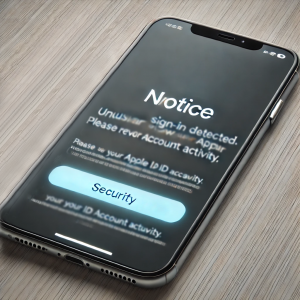
For example, a typical Apple security warning on iPhone could inform you of a suspicious login attempt or recommend changing your password for enhanced security. Such alerts are designed to inform rather than frighten, guiding you to take appropriate actions through secure routes like the Settings app or the official Apple website.
Common Types of Notifications Sent by Apple
-
Software Update Alerts:
Regularly, Apple will notify you about available software updates to enhance security and functionality, directing you to ‘Settings’ > ‘General’ > ‘Software Update’ to initiate the process.
-
Apple ID Security Notifications:
If there’s unusual activity related to your Apple ID, such as an unrecognized login attempt, you’ll receive a security alert on iPhone encouraging you to verify this activity to ensure it was you.
-
iCloud Storage Full Alerts:
Though primarily informational, alerts about nearing full iCloud storage are common but unrelated to direct security threats.
-
Find My iPhone Activation:
If your device is lost, activating Find My iPhone will trigger alerts when the device is located or turned on, part of Apple’s suite of security tools.
Identifying Phishing Scams Masking as Apple Alerts
Phishing attempts often mimic these legitimate notifications but include urgent requests or claim a fake message that virus has been detected on iPhone. Key red flags include grammatical errors, strange sender details, or links that do not lead to Apple’s official domain.
When encountering a security alert on iPhone, it’s safer to manually navigate to the recommended settings or features rather than clicking through provided links. For instance, if you get an Apple iPhone security alert about a compromised account, head directly to your settings to verify, avoiding any embedded links in the message.
Understanding the genuine appearance and content of Apple iPhone security alert helps users effectively sidestep security alert scams. Always exercise caution, and when unsure, directly consult Apple’s official support channels for verification. This proactive approach ensures your personal information remains secure against deceptive fake virus messages on iPhone.
Common Characteristics of Fake Apple Security Warning on iPhone
Understanding the common characteristics of fake Apple security warnings on iPhone can be crucial for users to protect themselves from phishing and scams. Scammers frequently imitate iPhone security alerts to trick users into divulging personal details or installing malicious software. Recognizing these fake alerts’ traits is essential to maintaining your digital safety.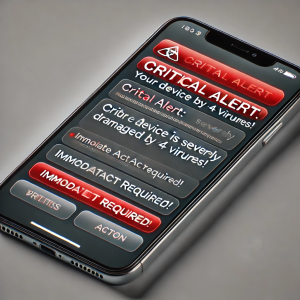
Key Indicators of a Fake iPhone Security Alert
Fake Apple security warnings on iPhone often share certain tell-tale signs that can alert you to their fraudulent nature:
-
Urgency in Message Tone:
One of the primary tactics used in an iPhone virus alert scam is creating a sense of urgency. Messages might claim that immediate action is required to prevent account deactivation or loss of data. Authentic Apple security alert on iPhone do not pressure users with urgent deadlines.
-
Requests for Personal Information:
Any security warning on iPhone that asks directly for your Apple ID password, credit card information, or other personal credentials is a definite red flag. Legitimate Apple security warning on iPhone will never ask for sensitive information via pop-ups or unsolicited messages.
-
Poor Grammar and Spelling:
Professional standards are a hallmark of real Apple communications. If an alert is riddled with grammatical errors and spelling mistakes, it’s likely a bogus virus message on iPhone.
-
Unprofessional Visuals and Layout:
Look for inconsistencies in the visual design of the alert. A fake Apple security warning on iPhone might use low-quality images, misaligned logos, or look significantly different from the sleek design typically associated with Apple products.
-
Suspicious Links and URLs:
Authentic Apple iPhone virus warnings pop up from genuine sources and contain no hyperlinks. If an alert includes a clickable link, especially one that does not lead to an official Apple domain (e.g., ending in apple.com), it’s likely a scam.
Examples of Phishing Attempts
- An alert claims your iPhone is infected with a virus and requires you to immediately download an antivirus tool from a non-Apple website.
- A security warning on iPhone pops up while browsing, urging you to call a support number to reactivate your supposedly locked Apple ID.
- A text message stating that your iCloud account has been breached and prompting you to secure it by entering your login details on a suspicious site.
By familiarizing yourself with the characteristics of fake Apple security warnings on iPhone, you can effectively avoid falling victim to iPhone virus alert scams and other phishing attempts that threaten your personal and device security. Always stay cautious and verify through reliable sources.
How Fake Security Alert on iPhones Work
Navigating the intricate landscape of iPhone security requires an understanding of how security scams, particularly fake Apple security warnings on iPhone, operate. These scams utilize diverse phishing methods such as SMS, email, and malicious pop-ups to exploit vulnerabilities. Increasing your awareness of these methods will equip you with the knowledge to safeguard your personal information and device integrity.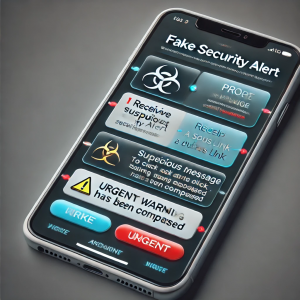
Diverse Phishing Methods Employed on iPhones
-
SMS Phishing (Smishing):
Scammers often send fraudulent Apple security alert on iPhone via SMS, falsely claiming suspicious account activity or urgent account verification needs.
-
Email Phishing:
These emails are crafted to mimic official Apple security alert on iPhone, complete with nearly authentic Apple logos and language that creates a sense of immediate action needed to update your credentials or confirm your personal information.
-
Pop-Up Phishing:
Encountering pop-ups while browsing on your iPhone might expose you to iPhone virus alert pop ups, which deceitfully warn about viruses and direct users to harmful sites to download malware disguised as antivirus software.
Step-by-Step Execution of iPhone Phishing Scams
-
Initial Contact:
An unsolicited iPhone security alert appears, via SMS, email, or pop-up, claiming there is a critical issue with your Apple account or device.
-
Creating Urgency and Fear:
The message instills urgency, often falsely stating that your account will be locked or your device will malfunction if immediate action is not taken. This psychological tactic is meant to induce panic and haste.
-
Suggested Immediate Action:
The scam message advises actions such as clicking a link to verify your account, downloading software to address a virus message on iPhone, or inputting your credentials on a spoofed website.
-
Harvesting Information:
Following the instructions in the scam can lead to personal information theft, malware installation, or unauthorized access to your device and accounts.
Common Scam Messages and Psychological Tricks
-
Text Example:
“Immediate action required: Your Apple ID has been disabled due to unusual activity. Verify your identity now at [fake link] to avoid permanent deactivation.”
-
Email Example:
“Notice: We’ve detected unauthorized attempts to access your Apple account. Secure your account by clicking here immediately.”
-
Pop-Up Example:
“Apple iPhone Virus Warning: Immediate action needed – Your iPhone has detected a Trojan virus. Download this removal tool now to protect your device.”
Scammers leverage psychological manipulation by instilling fear and urgency, using phrases like “immediate action required” or “urgent attention needed.” These tactics are designed to make users act impulsively, bypassing rational evaluation to quickly respond to these bogus Apple iPhone virus warning.
By recognizing these tactics and the common methods used in fake iPhone security alerts, you can better defend against these Apple security warnings on iPhone and other deceptive schemes. Always pause to verify any unexpected communication through official channels and refrain from entering personal details on unverified sites or downloads.
Immediate Steps to Take if You Encounter a Fake Security Warning on iPhone
When you encounter what appears to be a fake Apple security warning on iPhone, it’s crucial to handle the situation with care to secure your personal information and device. Below is a step-by-step guide on how to respond effectively if you receive a suspicious iPhone security alert or any other type of bogus virus message on iPhone.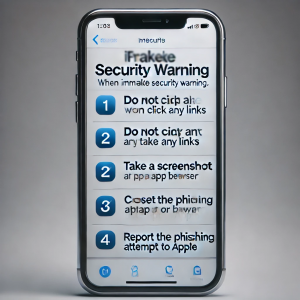
-
Do Not Interact with the Alert:
If you receive an iPhone virus alert pop up, Trojan virus alert or any virus message on iPhone, the first and most important action is to avoid interacting with the alert. Do not click on any links, do not enter any personal information, and do not download any attachments or software that may be suggested.
-
Take a Screenshot for Reporting:
Capture a screenshot of the fake Apple security warning on iPhone or the Apple iPhone virus warning. This can be useful for reporting the phishing attempt to relevant authorities or Apple support. It helps them track and possibly shut down the scam operation.
-
Close the Application or Browser:
If the bogus virus message on iPhone appears while you are using a web browser, close the browser immediately. If it’s an app that’s displaying these pop-ups, double-click the Home button or swipe up on the Home gesture bar (for iPhones without a Home button), and swipe up on the app to close it entirely.
-
Clear Browser History and Data:
If the iPhone security alert pops up while browsing, clear your browser history and web data. Go to Settings > Safari, and tap ‘Clear History and Website Data.’ For other browsers, find the similar setting and clear the data to prevent any malicious cookies or data from affecting your device.
-
Update Your Device’s Security:
Ensure your iPhone is running the latest iOS version, which often includes security patches that protect against such scams. Go to Settings > General > Software Update and download and install any available updates.
-
Change Your Apple ID Password:
If you suspect that your information might have been compromised before recognizing the Apple iPhone Trojan virus warning as a scam, change your Apple ID password quickly. Go to Settings > [your name] > Password & Security > Change Password.
-
Report the Incident:
Report the fake security alert on iPhone to Apple. Visit Apple’s official website and navigate to the support section to report phishing. You can also use this to verify whether an alert you received is legitimate.
-
Educate Yourself and Others:
Stay informed about the latest phishing techniques and Apple iPhone security alerts. Educate family and friends on how to recognize and respond to this fake Apple security warning on iPhone. The more knowledgeable you are, the less likely you are to fall victim to such scams.
By following these steps, you can protect yourself from the dangers of fake Apple security warning on iPhone and other deceptive alerts that threaten your digital safety.
Long-Term Prevention Strategies for iPhone Security
Ensuring your iPhone remains secure against various threats, including iPhone security alert pop ups, iPhone virus message pop ups, and other malicious activities, requires proactive and ongoing measures. Here are some best practices and steps to enhance the security settings on your iPhone to prevent future attacks and to minimize the impact of fake Apple security warning on iPhone.
-
Update Your iOS Regularly:
One of the most effective ways to keep your iPhone secure is to regularly update your operating system. Apple frequently releases updates to patch security vulnerabilities that can protect your device from fake virus messages on iPhone. To check for updates:
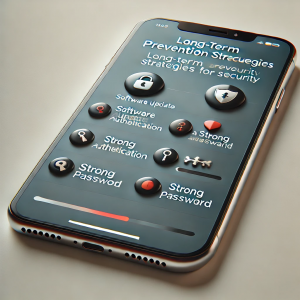
- Go to Settings > General > Software Update.
- Click Download and Install if an update is available.
-
Enable Two-Factor Authentication:
Two-factor authentication gives an extra layer of security by requiring a second form of verification in addition to your password. This can prevent unwanted access even if your password is compromised. To make your Apple ID two-factor authenticated:
- Navigate to Settings > [your name] > Password & Security.
- Select Turn On Two-Factor Authentication and adhere to the prompts displayed on the screen.
-
Use Strong, Unique Passwords:
Using strong, unique passwords for your Apple ID and other accounts can prevent breaches. Avoid using easy-to-guess simple passwords, such as birthdays or sequential numbers. Consider to use a password manager to create and keep complex passwords.
-
Be Wary of Suspicious Links and Attachments:
Educate yourself to be skeptical of unsolicited iPhone security alerts, especially those that come via email or as pop ups. Never tap on links or download attachments from unknown or suspicious sources as they may lead to fake Apple security warning on iPhone.
-
Regularly Backup Your Data:
Regular backups can save your data in case of malware attacks or data loss. Use iCloud or iTunes to back up your iPhone regularly:
- For iCloud, go to Settings > [your name] > iCloud > iCloud Backup > Back Up Now.
- For iTunes, connect your iPhone to your PC, open iTunes, choose your device, and click ‘Back Up Now.’
-
Monitor and Restrict App Permissions:
Be cautious about which apps have permissions to access your camera, microphone, location, and personal data. Regularly review app permissions in Settings and restrict them to only those necessary for the app’s functionality.
-
Educate Yourself on Phishing Techniques:
Staying informed about the latest phishing scams and recognizing Apple iPhone virus warnings can significantly reduce the risk of falling victim to fraud. Apple provides resources and community support forums where users can learn about new threats and how to handle them.
-
Use Secure Wi-Fi:
Avoid using public or unsecured Wi-Fi networks for sensitive transactions. If necessary, use a reliable VPN to encrypt your internet connection, which can protect you from cyber threats like fake iPhone virus pop ups and data interception.
By implementing these long-term prevention strategies, you can significantly bolster the security of your iPhone against fake Apple security warning on iPhone and other cybersecurity threats. Always stay vigilant and proactive about device security to protect your personal information and maintain optimal device performance.
FAQs
Q1. What does a legitimate Apple security alert on iPhone look like?
- A. A legitimate Apple security alert on iPhone is straightforward, professional, and will never ask for personal information such as your Apple ID password directly through a pop-up or unsolicited message. These alerts typically guide you to review settings within your device or to visit the official Apple website.
Q2. What should I do if I receive bogus Apple security alerts on my MacBook?
- A. Immediately close any suspicious alerts, do not click on any links, and report the incident to Apple Support. Ensure your macOS is up-to-date to help prevent future alerts. If you still receive these alerts, you can read our in-depth blog on Fake Apple Security Warning and stop receiving the alerts.
Q3. How can I differentiate between a real and a fake Apple security warning on iPhone?
- A. To differentiate a real from a fake Apple security warning on iPhone, check for urgent language that demands immediate action, requests for personal information, and any grammatical or spelling errors. Authentic alerts will direct you to secure settings without external links.
Q4. What should I do if I receive a virus message on iPhone?
- A. If you receive a virus message on iPhone, do not interact with the message. Instead, close the app or browser, clear your history and web data, and report the incident to Apple through their official support channels.
Q5. Are iPhone virus alert pop ups legitimate?
- A. iPhone virus alert pop ups are usually scams. Apple does not send virus warnings through browser pop-ups. Always verify any virus alerts by checking your device settings or contacting Apple support directly.
Q6. Can an iPhone virus warning pop up if my device is actually infected?
- A. An iPhone virus warning pop up is unlikely to be legitimate as iOS does not support this type of security alert through pop-ups. Most warnings about viruses on iPhones are generated by malicious websites to deceive users.
Q7. How do I handle a Trojan virus alert on iPhone?
- A. For a Trojan virus alert on iPhone, do not tap on any links or download any suggested software as these are common tactics in phishing scams. Instead, secure your device by updating your iOS and changing passwords if necessary.
Q8. What are the signs of an iPhone pop up virus warning?
- A. Signs of an iPhone pop up virus warning include unexpected pop-ups claiming that your iPhone is infected, prompts to download software immediately, and links to non-Apple websites. These are typically scams aimed at extracting personal information.
Q9. How can I secure myself from fake security warning on iPhone?
- A. Protect yourself from fake security warning on iPhone by keeping your iOS up-to-date, enabling two-factor authentication, using strong passwords, and educating yourself about common phishing tactics. Always verify alerts through official Apple channels.
Q10. What does an apple iPhone Trojan virus warning typically look like?
- A. A fake apple iPhone Trojan virus warning often looks alarming, with urgent messages to act immediately. Real Apple communications are more measured and will never ask for sensitive information directly or urge you to download software from unverified sources.
Conclusion
As we continue to integrate more of our lives with digital technology, understanding the critical need to stay vigilant against fake Apple security warning on iPhone and other cyber threats becomes increasingly important. It’s essential to approach every iPhone security alert, whether it signals a virus message on iPhone or specifically a Trojan virus alert on iPhone, with a high degree of scrutiny. These sophisticated scams, including iPhone virus alert scams and iPhone virus pop up warnings, are designed to mimic legitimate alerts, making them difficult to immediately identify as fraudulent.
Keeping an eye on and staying informed about the latest digital security threats are fundamental to safeguarding your information. Educate yourself regularly through reliable sources such as Apple’s official support pages and reputable cybersecurity blogs, which can provide insights into the newest tactics employed by cybercriminals. Beyond staying informed, it is also crucial to actively manage your device’s security through routine updates, enabling two-factor authentication, and carefully monitoring app permissions. You can also call us on the support number provided on our Apple Support page. Our support team will assist you properly so that you can get rid of these fake security alerts on your iPhone.
By adopting these practices, you not only reduce the risk of encountering security warning on iPhone, but also strengthen your overall defense against the broader spectrum of digital security threats. Always verify the authenticity of any alarming security alert, and remember that protecting your digital information requires both constant vigilance and proactive security measures. This dual approach is your best defense against the growing challenges posed by cyber attacks in today’s digital world.

